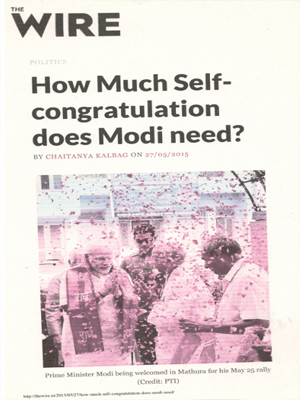How much self-congratulation does Modi need?
Published date: 27 May 2015, The Wire
Prime Minister Narendra Modi and his team have had a lot of time to polish the report card on their year in power. I woke up on Anniversary Day determined, like Norman Vincent Peale, to feel The Power of Positive Thinking. Whatever the opinion polls or the trolls on Twitter said, we had to be fair to the government. There was too much negativity around. The report card was besmirched by unfair B-minuses and ‘could do more’s. Thousands of words had been spoken by Modi’s lieutenants in the run-up to the anniversary. Only External Affairs Minister Sushma Swaraj, who has been busy visiting Tier Two world capitals that the Prime Minister himself could not manage, was strangely silent.
Honestly though, there are enough other anniversaries this year to keep us busy – the 70th anniversaries of the end of World War Two and the annihilation of Hiroshima and Nagasaki for instance. And not to forget the 200th anniversary of the Battle of Waterloo and the 800th anniversary of the Magna Carta.
Not to be left behind, the Modi government’s High Level National Implementation Committee also met last week to chalk out a few other Indian anniversaries, including the 475th birth anniversary of Maharana Pratap, the valiant Rajput warrior who fought Mughal Emperor Akbar, and the 500th anniversary of Chaitanya Mahaprabhu’s return to Vrindavan.
But to come back to the Big Anniversary, thoughts of N.V. Peale were soon overtaken yesterday by the sight of big newspaper advertisements that began “My dear fellow Citizens!” and towards the end, “Friends, this is just the beginning with the prime minister’s signature at the bottom. After that it was all Modi, Modi, Modi as every crowd of diasporic Indians chants when our leader appears in their midst.
Looking for details of all that had been achieved over the past year, I was struck by the fact that the slickest slides and visuals on the year of achievements were all on the prime minister’s
station does med red personal website, (www.narendramodi.in)
(http://www.narendramodi.in). I searched in vain for equally colourful presentations on the websites of the Press Information Bureau, or the much-touted mygov.in, or even the Bharatiya Janata Party’s own site which did inject some anaemic colour.
There has been much purposefulness since May 26, 2014. Modi has taken forward some of the iniatives of the Congress-led United Progressive Alliance. Global oil prices plunged (they are starting to inch up again now), commodity prices crashed, and Europe and Japan continued to suffer economic malaise. It has been a lucky year for Modi, and the worm could be turning – the Indian stock market has somewhat lost its shine, foreign investors are lukewarm, business capital formation is moribund, and lakhs of farmers are staring at hunger and penury.
You wouldn’t know this if you have been swept away by the tide of self-congratulation. But then Narendra Modi did not invent report cards. The UPA also issued a report card on its first year in power in 2005. The UPA’s Common Minimum Programme even sounded eerily similar to the National Democratic Alliance’s priorities, down to the burning desire to do more for the poor farmer. Of course the UPA could not boast about soil health cards and it was left to Modi to launch the state-run Kisan Channel for farmers. One Punjab farmer told me he hoped Doordarshan would tell him how he got just Rs 6 per kilogram of tomatoes at the mandi and they fetched ten times as much in the nation’s capital.
Ten years ago, however, the UPA-1 coalition was already in coalition paralysis, with the Left parties protesting every reform. L.K. Advani, then the BJP president, delivered a long speech to his party executive in September 2005. It was punctuated by several interesting sub-headings:
• Nation’s misfortune a weak prime minister
• Sinister designs of the Left • Foreign policy in drift
• Congress’s divide and rule policy
• National security in jeopardy
Advani, who emerged unscathed from the BJP’s humbling defeat in the 2004 elections, had to step down from the party’s leadership in December 2005, not least because he said some rather nice things about Pakistan’s founder Mohammad Ali Jinnah. And of course Narendra Modi is lucky not to be hemmed in by his allies, and foreign policy is certainly not in drift after his incessant travels.
One other stark difference between Then and Now (this is how one presentation on Modi’s website is titled) is that the UPA did not boycott the just-concluded Budget session of parliament. In fact this was the most productive parliament session in 15 years. Back in 2005, the NDA absented itself from key legislation like the Right to Information Act, which the Modi government is quietly throttling.
The one-year excitement is pointless: we have been told that Modi is in for the long haul and thinks in two terms (in power that is). We should hope that his second year in office is marked by less rancour and polarisation, more jobs and really lower vegetable prices. Most of the people he has wanted to place in important positions have already been placed. So all this feverish stock-taking seems a bit déclassé as the French would say. It is a smidgen of history.
Modi’s flailing opponents will also do well to buckle down to running their bits of India more efficiently. Time is on their side. They should note the 600th anniversary of the Battle of Agincourt this October. There, Henry V’s small army, wielding only long bows, defeated a superior French force five times its size but clad in too much arrogance and heavy armour. It is a parable of how you can never protect yourself enough against an agile and persevering foe.
(Chaitanya Kalbag, an award-winning journalist and a former Asia Editor at Reuters and Editor-in-Chief at Hindustan Times, has been writing for over 40 years. He tweets at @chaitanyakalbag)
